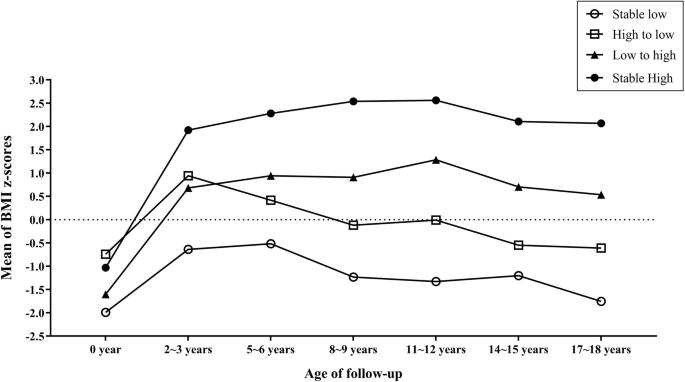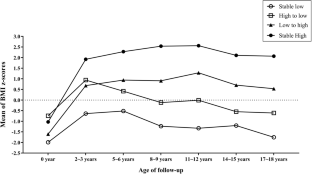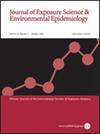Maternal phthalate exposure and BMI trajectory in children—an 18-year birth cohort follow-up study
IF 4.7
3区 医学
Q2 ENVIRONMENTAL SCIENCES
Journal of Exposure Science and Environmental Epidemiology
Pub Date : 2024-06-19
DOI:10.1038/s41370-024-00696-5
引用次数: 0
Abstract
Obesity is a major health concern worldwide. Previous studies have suggested that phthalate plasticizers are obesogens. However, the relationship between early-life phthalate exposure and long-term obesity development remains unknown. We investigated the association between prenatal phthalate exposure and children’s body mass index (BMI) patterns in an 18-year birth cohort follow-up study in Taiwan. Our analytical lab quantified seven phthalate metabolites in maternal urine during pregnancy using quantitative liquid chromatography-tandem mass spectrometry. In addition, we calculated BMI z scores for participated children at each follow-up, utilized trajectory analysis to describe children’s BMI z-score patterns at 2–18 years of age, and adopted generalized estimating equations (GEE) and multivariate logistic regression models to assess the association between prenatal phthalate exposure and BMI z scores in children. A total of 208 mother-child pairs were included in the analysis. Maternal urinary diethyl phthalate (DEP) metabolites were associated with the increase of BMI z scores in children aged 2–18 years in the GEE model. Doubled maternal urinary ∑mDEHP (3 mono hexyl-metabolites of di-ethyl-hexyl phthalate (DEHP) increased the risk of children being in the stable-high BMI trajectory group until the age of eighteen. We observed that BMI trajectories of children remained stable after the age of 5 years. During each follow-up, a higher frequency of overweight or obese was observed in children, ranging from 15.9% to 35.6% for girls and 15.2–32.0% for boys, respectively. Prenatal phthalate exposure was associated with increasing BMI z scores in children. Prenatal DEHP exposure was associated with a stable-high BMI trajectory in children up to the age of 18 years.


母亲邻苯二甲酸盐暴露与儿童体重指数轨迹--18 年出生队列随访研究。
背景:肥胖是全球关注的主要健康问题。以往的研究表明,邻苯二甲酸酯类增塑剂是肥胖的诱发因素。然而,生命早期接触邻苯二甲酸酯与长期肥胖发展之间的关系仍然未知:我们在台湾进行了一项为期 18 年的出生队列随访研究,调查了产前邻苯二甲酸酯暴露与儿童体重指数(BMI)模式之间的关系:我们的分析实验室采用定量液相色谱-串联质谱法对孕期母体尿液中的七种邻苯二甲酸酯代谢物进行了定量分析。此外,我们还计算了每次随访时参与儿童的 BMI z 分数,利用轨迹分析法描述了儿童 2-18 岁时的 BMI z 分数模式,并采用广义估计方程(GEE)和多元逻辑回归模型评估了产前邻苯二甲酸酯暴露与儿童 BMI z 分数之间的关联:共有 208 对母婴被纳入分析。在GEE模型中,母体尿液中邻苯二甲酸二乙酯(DEP)代谢物与2-18岁儿童BMI z分数的增加有关。母体尿液中的∑mDEHP(邻苯二甲酸二乙基己酯(DEHP)的3种单己基代谢物)增加了儿童在18岁之前处于稳定的高BMI轨迹组的风险:我们观察到,儿童的体重指数轨迹在 5 岁后保持稳定。在每次随访中,我们都观察到儿童超重或肥胖的频率较高,女孩和男孩的超重或肥胖率分别为 15.9% 至 35.6%和 15.2% 至 32.0%。产前接触邻苯二甲酸盐与儿童体重指数 z 值的增加有关。产前接触 DEHP 与 18 岁以下儿童稳定的高 BMI 轨迹有关。
本文章由计算机程序翻译,如有差异,请以英文原文为准。
求助全文
约1分钟内获得全文
求助全文
来源期刊
CiteScore
8.90
自引率
6.70%
发文量
93
审稿时长
3 months
期刊介绍:
Journal of Exposure Science and Environmental Epidemiology (JESEE) aims to be the premier and authoritative source of information on advances in exposure science for professionals in a wide range of environmental and public health disciplines.
JESEE publishes original peer-reviewed research presenting significant advances in exposure science and exposure analysis, including development and application of the latest technologies for measuring exposures, and innovative computational approaches for translating novel data streams to characterize and predict exposures. The types of papers published in the research section of JESEE are original research articles, translation studies, and correspondence. Reported results should further understanding of the relationship between environmental exposure and human health, describe evaluated novel exposure science tools, or demonstrate potential of exposure science to enable decisions and actions that promote and protect human health.

 求助内容:
求助内容: 应助结果提醒方式:
应助结果提醒方式:


